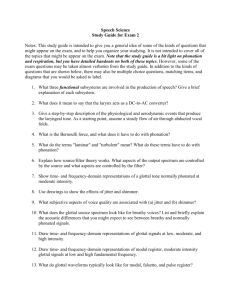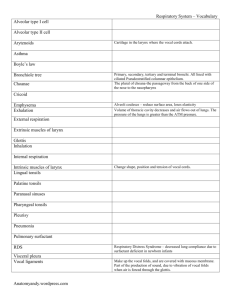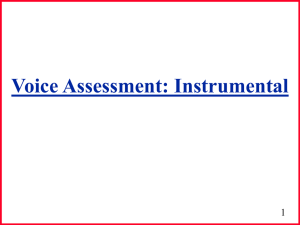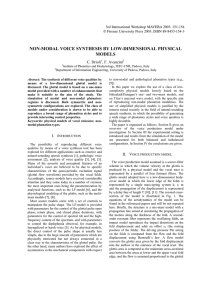Phonation Part 1
advertisement
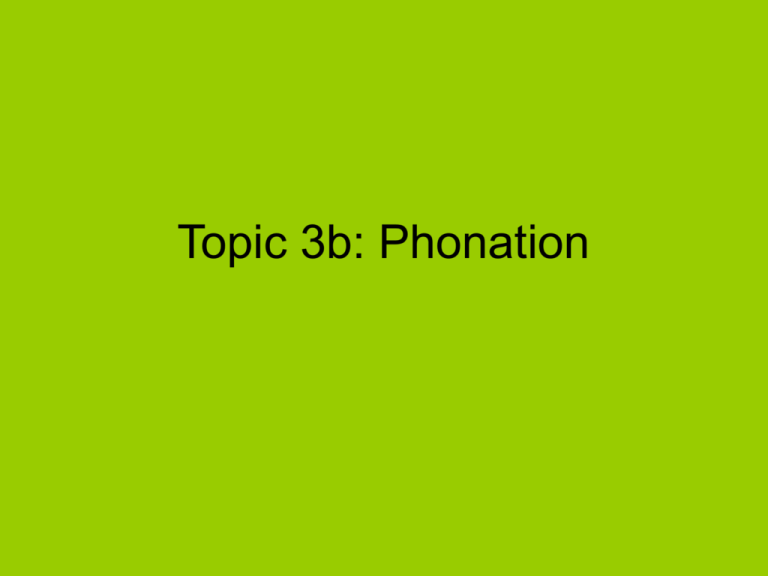
Topic 3b: Phonation Learning Objectives • Possess a knowledge of laryngeal anatomy sufficient to understand the biomechanics and acoustics of phonation Behrman Chapter 5, 6 Place less emphasis on… • Minor anatomical landmarks and features • Extrinsic muscles of the larynx • Blood supply to the larynx • Central motor control of larynx • Peripheral Sensory control of larynx • Stress-Strain Properties of Vocal Folds What is the basic role of the larynx in speech and song • Sound source to excite the vocal tract – Voice – Whisper • Prosody – Fundamental frequency (F0) variation – Amplitude variation • Realization of phonetic goals – – – – – Voicing Devoicing Glottal frication (//, //) Glottal stop (//) Aspiration • Para-linguistic and extra-linguistic roles – Transmit affect – Speaker identity The vocal fold through life… • Newborns – No layered structure of LP – LP loose and pliable • Children – Vocal ligament appears 1-4 yrs – 3-layered LP is not clear until 15 yrs • Old age – Superficial layer becomes edematous & thicker – Thinning of intermediate layer and thickening of deep layer – Changes in LP more pronounced in men – Muscle atrophy Learning Objectives • Describe a single cycle of vocal fold oscillation • Describe why phonation is considered “quasiperiodic” • Describe the relationship between vocal fold motion (kinematics), laryngeal aerodynamics and sound pressure wave formation • Describe and draw idealized representations of the glottal sound source Complexity of vocal fold vibration Vertical phase difference Longitudinal phase difference The Glottal Cycle Phonation is actually quasi-periodic • Complex Periodic – vocal fold oscillation • Aperiodic – Broad frequency noise embedded in signal – Non-periodic vocal fold oscillation – Asymmetry of vocal fold oscillation – Air turbulence • Voicing vs. whispering Flow Glottogram Synchronous plots Sound pressure waveform (microphone at mouth) Glottal Airflow (inverse filtered mask signal) Glottal Area (photoglottogram) Vocal Fold Contact (electroglottogram) Instantaneous sound pressure Sound pressure wave Time Learning Objectives • Briefly describe range of instruments used to capture phonatory behavior • Explain vocal fold motion using the 2-mass model version of the myoelasticaerodynamic theory of phonation Measuring Glottal Behavior • Videolaryngoscopy – Stroboscopy – High speed video illumination Photoglottography (PGG) Time Electroglottography (EGG) • Human tissue = conductor • Air: conductor • Electrodes placed on each side of thyroid lamina • high frequency, low current signal is passed between them • VF contact = impedance • VF contact = impedance Electroglottogram Glottal Airflow (volume velocity) • Instantaneous airflow is measured as it leaves the mouth • Looks similar to a pressure waveform • Can be inverse filtered to remove effects of vocal tract • Resultant is an estimate of the airflow at the glottis Glottal Aerodynamics • Volume Velocity • Driving Pressure • Phonation Threshold Pressure – Initiate phonation – Sustain phonation • Laryngeal Airway Resistance Myoelastic Aerodynamic Theory of Phonation Necessary and Sufficient Conditions • Vocal Folds are adducted (Adduction) • Vocal Folds are tensed (Longitudinal Tension) • Presence of Aerodynamic pressures (driving pressure) 2-mass model Upper part of vocal fold Mechanical coupling stiffness Lower part of vocal fold Coupling between mucosa & muscle TA muscle •VF adducted & tensed → myoelastic pressure (Pme ) •Glottis is closed •subglottal air pressure (Psg) ↑ •Psg ~ 8-10 cm H20, Psg > Pme •L and R M1 separate •Transglottal airflow (Utg) = 0 As M1 separates, M2 follows due to mechanical coupling stiffness Psg > Pme glottis begins to open Psg > Patm therefore Utg > 0 Utg ↑ ↑ since glottal aperature << tracheal circumference Utg ↑ Ptg ↓ due to Bernoulli effect Pressure drop across the glottis Bernoulli’s Law P + ½ U2 = K where P = air pressure = air density U = air velocity Utg ↑ Ptg ↓ due to Bernoulli effect Plus “other” aerodynamic effects Ptg < Pme M1 returns to midline M2 follows M1 due to mechanical coupling stiffness Utg = 0 Pattern repeats 100-200 times a second Limitations of this simple model


